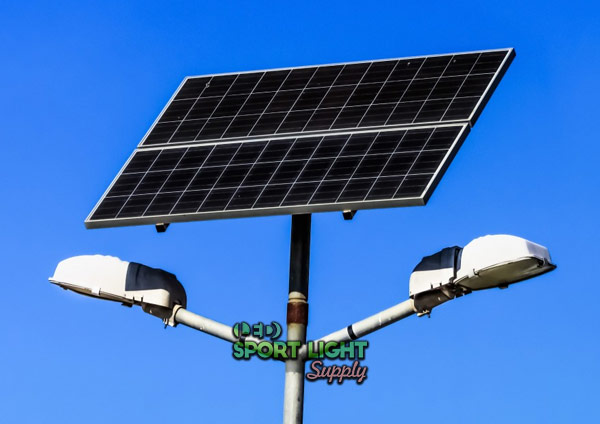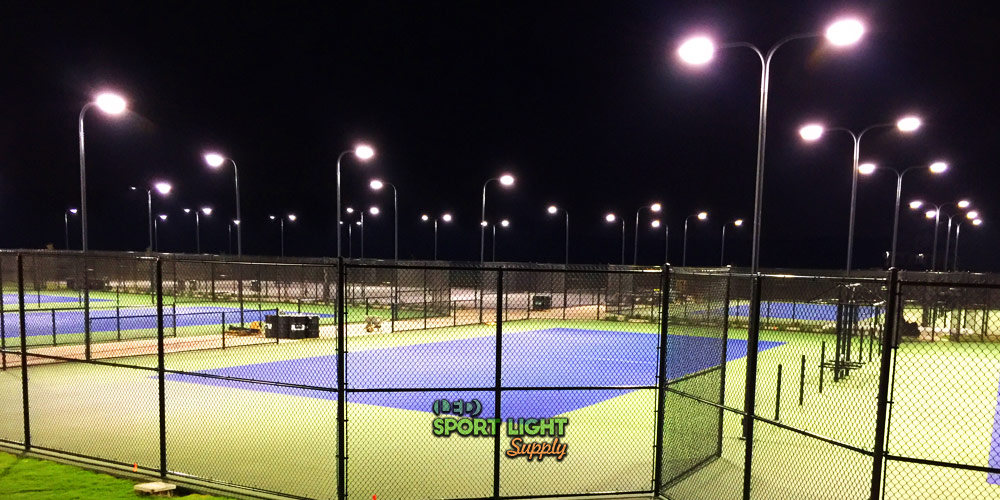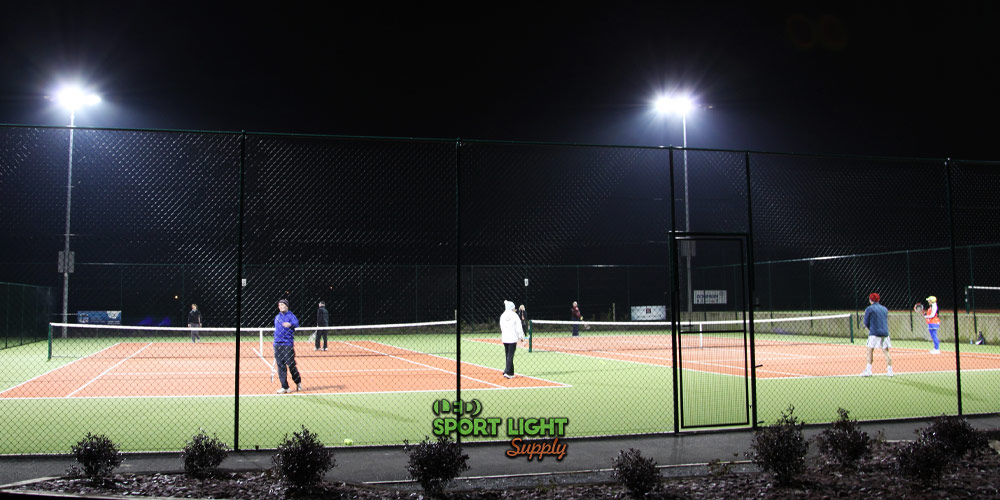Is it possible to use solar lights on a tennis court? Solar power has become increasingly popular in recent years. While installing solar panels on a tennis court was prohibitively expensive 20 to 30 years ago, technological advancements have made it far more accessible. The development of lithium-ion batteries has brought significant benefits, such as shorter charging times and extended usage hours. These advantages are now being applied to sports facilities and outdoor courts, making solar-powered lighting a practical option for tennis courts today.
Table of Contents
ToggleWhat is Solar Tennis Court Lighting?

Solar tennis court lighting is an innovative addition to LED tennis court illumination, allowing solar panels to harness energy during the day. These panels are mounted on the LED fixture brackets and charge a battery unit, enabling the LED lights to operate at night. This technology offers several advantages, making it easier to enjoy tennis even after sunset. The LED lighting powered by these solar panels can illuminate a tennis court with brightness comparable to daylight.
The solar panels used for this purpose are compact enough to be mounted above each lighting fixture. However, they can also be installed on rooftops, storage sheds, or other structures as long as the wiring connects the solar panels and their battery to the LED tennis court lights. The optimal placement of solar panels is where sunlight is most abundant throughout the day. Areas with excessive shade may reduce the efficiency of the panels due to shadows.
The Popularity of Solar Tennis Court Lighting
The rise of solar tennis court lighting aligns with the growing emphasis on green energy and sustainability. This shift in thinking about energy conservation has been significant, with LED lighting playing a crucial role in reducing energy consumption. Solar panels have become more common in various applications, including portable devices like laptops and smartphones, and now in sports lighting.
One of the main benefits of solar tennis court lighting is its cost-effectiveness, as it significantly reduces electricity bills. Beyond the financial advantages, solar lighting serves as a powerful reminder of the practicality of harnessing free energy from the sun. The sun, being the most powerful light source in our solar system, offers an endless supply of energy that can now be efficiently captured and used for various purposes, including nighttime sports like tennis. The popularity of night lighting for tennis courts has grown as it provides players with the freedom to enjoy the game at any time.

Advantages of Using LED Solar Battery-Powered Flood Lights in Tennis Courts
Energy Savings and Reduced Running Costs
Switching to LED sports flood lighting has led to significant reductions in electricity bills, with savings of 75-85% compared to traditional lighting. Tennis court owners, both private and commercial, are increasingly adopting this cost-effective solution to minimize their electrical overheads. Even homeowners with built-in tennis courts benefit from these savings. The lower wattage of LED floodlights makes solar-powered electricity a viable option for court lighting. Solar-charged batteries can power the lights at night, and the latest lithium-ion batteries can hold a charge sufficient for half a night’s use. In the event of a power outage, battery-powered lighting ensures that nighttime games can continue uninterrupted, providing peace of mind for homeowners and private clubs.
Easy Installation and Wireless Lighting
Solar lighting simplifies the installation process by eliminating the need for extensive wiring. The solar-powered lights can be easily attached to poles or positioned at the corners of a tennis court fence. This wireless system is particularly advantageous for courts without existing poles, resulting in a cleaner, less cluttered appearance.

Automatic On/Off with Dusk-to-Dawn Lighting Sensors
Solar tennis court lights are designed for those who prefer a hands-off approach to lighting control. Many solar panels are equipped with built-in photocells that detect ambient light levels. When the brightness drops below a certain level, the floodlights automatically turn on. This feature is ideal for tennis clubs or players who regularly practice at night.
Smart Control via Bluetooth
Controlling the brightness and on/off settings of solar lights can be a challenge if they are installed at a considerable height. However, some solar tennis court floodlights come with Bluetooth modules, allowing wireless communication between the lighting fixtures and smartphones. With a simple app, players can adjust the brightness or turn the lights on and off without the need for ladders or additional equipment.
Disadvantages of Using LED Solar Battery-Powered Flood Lights
Charging Limitations on Cloudy Days
While solar panels can generate electricity on cloudy days, the output is significantly reduced, leading to longer charging times. The efficiency of energy conversion depends on the type of inverter used to transform the DC current produced by the photovoltaic cells into AC current, which is then stored in lithium-ion batteries.
Lower Energy Conversion Rate
The efficiency of solar panels varies, with current technology achieving conversion rates of 15-20%, and some advanced panels reaching up to 23%. Although these rates may seem low, they represent significant improvements over older technologies. This efficiency is sufficient for powering LED lighting, which requires less energy, making solar LED floodlights a practical option for residential or recreational tennis courts.
Battery Storage Capacity
The size of the battery required depends on the amount of electricity needed. While LED lights consume less energy, the number of LED floodlights and their usage determines the battery size. Lithium-ion batteries can store substantial amounts of power, with some capable of powering an electric lawn mower for up to 1-2 hours with a 7.5Ah battery.
Initial Investment Costs
The initial cost of solar-powered LED lighting may seem high, but this is offset by the long-term savings and benefits. Over the past few decades, the cost of green energy has decreased significantly, making solar power more accessible. Considering that LED lights, solar panels, and batteries often come with warranties lasting 10-25 years, the investment is well worth it for long-term returns.
Solar Tennis Court Lighting Questions and Answers
How is Solar Energy Converted into Electricity for Tennis Court Lighting?
Solar energy is harnessed through photovoltaic cells within the solar panels, which are activated by direct sunlight. This process generates direct current (DC) voltage, which is then routed through an inverter that converts the DC voltage into alternating current (AC). The AC current is subsequently directed into a battery charger, which charges the battery. Finally, a control switch connected by electrical cables from the battery supplies electricity back to the LED lights, powering the tennis court lighting.
How Many Solar Flood Lights Are Needed for a Tennis Court?
The number of LED floodlights required for a tennis court typically ranges from 4 to 6, although up to 8 lights may be necessary depending on the need to minimize shadows. The number of lights needed is influenced by the lumens and wattage of each fixture. Fewer lights, such as only 4, may result in more noticeable ground shadows.
How Should Solar Tennis Court Lights Be Maintained?
Maintaining solar tennis court lights is straightforward, as solar panels are most effective when kept clean. A simple cleaning cloth can be used to remove dust and debris, with baby wipes being particularly effective due to their non-abrasive nature and compostability. Regular cleaning, typically every few days, ensures that the panels remain clear and able to capture sunlight efficiently.
How Much Does It Cost to Install Solar Lights in a Tennis Court?
The cost of installing solar lights in a tennis court varies depending on the contractor and the complexity of the installation. Factors such as the time required to install and properly aim the lights also affect the overall cost. Professional installation may come with higher fees, but these can often be negotiated. On average, the installation cost for a standard tennis court ranges from $6,000 to $12,000.
What Are the Charging Times and Usage Times for Solar Flood Lights?
The time required to charge a battery using solar power typically ranges from 2 to 3 hours, depending on the amount of sunlight available. On cloudy days, this charging time may double. Once fully charged, the LED lights can operate for 3 to 6 hours, providing ample time for a full tennis match of at least 5 sets.
Can Solar-Powered LED Tennis Court Lights Always Run from a Battery?
The reliability of battery-powered LED lights depends on the availability of sunlight to charge the battery. On days with limited sunshine, it may be challenging to fully charge the battery for nighttime use. However, an alternative option is to charge the battery using regular electricity, which can serve as a backup or a cost-saving measure. While this option reduces the reliance on solar power, it provides flexibility in ensuring the lights remain functional.
Does Battery-Powered LED Lighting Become Dimmer with a Low Battery?
LED lights require a consistent power supply to maintain their brightness. Unlike incandescent lights, LED lights do not gradually dim as the battery weakens; instead, they will simply turn off when the power is insufficient to keep them fully illuminated. The duration of light output depends on the size and capacity of the battery used.
Conclusion
Solar tennis court lighting presents a viable and sustainable option for illuminating outdoor courts, combining the advantages of modern LED technology with renewable energy. While there are some challenges, such as charging limitations on cloudy days and initial installation costs, the long-term benefits in terms of energy savings, easy installation, and environmental impact make solar-powered lights an attractive choice for tennis court owners. With advancements in solar technology and battery storage, these systems can reliably power courts for extended periods, ensuring that tennis enthusiasts can enjoy their game well into the night without relying solely on traditional electricity.
